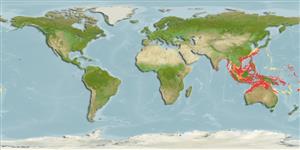>
Eupercaria/misc (Various families in series Eupercaria) >
Priacanthidae (Bigeyes or catalufas)
Etymology: Priacanthus: Greek, prion = saw + Greek, akantha = thorn (Ref. 45335).
More on author: Cuvier.
Environment: milieu / climate zone / depth range / distribution range
экология
морской ассоциированный с рифами; мигрирует в океане (Ref. 51243); пределы глубины 12 - 400 m (Ref. 90102). Subtropical; 32°N - 22°S
Western Pacific: southern Japan to western Indonesia, the Arafura Sea (Ref. 9819), and Australia. Reported from Peter the Great Bay (Ref. 27683).
Size / Вес / Возраст
Maturity: Lm ? range ? - ? cm
Max length : 30.0 cm SL самец/пол неопределен; (Ref. 48635)
колючие лучи спинного плавника (общее число) : 10; членистые (мягкие) лучи спинного плавника (общее число) : 12 - 14; колючие лучи анального плавника: 3; членистые (мягкие) лучи анального плавника: 13 - 14. Medium-sized fish of moderately deep body. The eyes large; the mouth oblique, with the lower jaw projecting upwards. The body tapers very slightly to beneath the middle of the soft portion of the dorsal fin, and then abruptly to the peduncle. This species is distinguished from P. fitchi by the presence of numerous rusty brown to yellowish spots in the membranes of the dorsal and anal fins, and its less tapered body.
Occurs in inshore and offshore reefs from less than 20 m to more than 400 m depths. Apparently forms aggregations in open bottom areas and is very abundant in the South China Sea and Andaman Sea. Marketed fresh, whole. Sound production has been studied in this species. Also found under ledges or hovering next to coral heads during day (Ref 90102).
Life cycle and mating behavior
половая зрелость | размножение | нерест | икра | Fecundity | личинки
Starnes, W.C., 1988. Revision, phylogeny and biogeographic comments on the circumtropical marine percoid fish family Priacanthidae. Bull. Mar. Sci. 43(2):117-203. (Ref. 5403)
Статус Красного Списка МСОП (Ref. 130435: Version 2024-2)
Угроза для людей
Harmless
Использование человеком
рыболовство: коммерческий
дополнительная информация
инструменты
Специальные отчеты
Скачать в формате XML
ресурсы в Интернет
Estimates based on models
Preferred temperature (Ref.
123201): 16.9 - 28, mean 24.4 °C (based on 682 cells).
Phylogenetic diversity index (Ref.
82804): PD
50 = 0.5002 [Uniqueness, from 0.5 = low to 2.0 = high].
Bayesian length-weight: a=0.01660 (0.01258 - 0.02189), b=2.91 (2.84 - 2.98), in cm total length, based on LWR estimates for this species (Ref.
93245).
Trophic level (Ref.
69278): 4.1 ±0.60 se; based on food items.
Generation time: 1.5 (1.1 - 2.2) years. Estimated as median ln(3)/K based on 15
growth studies.
устойчивость к внешним воздействиям (Ref.
120179): средний (среднего размера), минимальное время удвоения популяции 1.4-4.4 года (K=0.7-1.0; tmax=6).
Prior r = 0.32, 95% CL = 0.21 - 0.48, Based on 1 data-limited stock assessment.
Fishing Vulnerability (Ref.
59153): Low vulnerability (18 of 100).
Climate Vulnerability (Ref.
125649): High vulnerability (63 of 100).
Nutrients (Ref.
124155): Calcium = 42.3 [23.6, 84.7] mg/100g; Iron = 0.931 [0.514, 1.629] mg/100g; Protein = 20 [19, 21] %; Omega3 = 0.298 [0.158, 0.546] g/100g; Selenium = 28.8 [13.0, 59.1] μg/100g; VitaminA = 42.2 [14.1, 133.0] μg/100g; Zinc = 0.722 [0.458, 1.100] mg/100g (wet weight); based on
nutrient studies.
